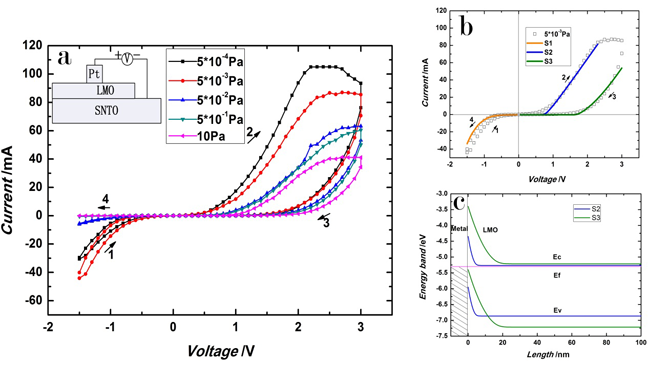Conventional semiconductor memory technologies are rapidly approaching their bottleneck to continue scaling down. Robust RRAM with great potential for high-density, high-speed, non-destructive read-out and non-volatility is one of the most promising candidates for the next generation memories and has attracted considerable attention. At present, a common perspective for underlying physical origins of the resistive switching phenomena in transition metal oxides is that the migration of oxygen vacancies (or oxygen ions) plays a dominant role. Due to extreme difficulty in directly observing oxygen vacancy, a direct proof of whether oxygen vacancies are responsible for the resistive switching behaviors would be hereby rather crucial for the further development of RRAM.
Recently, Prof. Kuijuan Jin and her research team at the Beijing National Laboratory for Condensed Matter Physics, the Institute of Physics, Chinese Academy of Sciences (IOP, CAS), have grown epitaxial LaMnO3 (LMO) thin films successfully by using laser molecular beam epitaxy. Dr. Zhongtang Xu, Prof. Kuijuan Jin, Dr. Can Wang, Prof. Huibin Lv, Prof. Guozhen Yang et al., cooperating with Prof. Lin Gu, have revealed an annular-bright-field scanning transmission electron microscopy, which can image oxygen atoms directly in LMO thin film fabricated under various oxygen pressures. This results directly confirmed that with the decrease of the grown oxygen pressure the number of oxygen vacancies becomes larger. Synchrotron-based X-ray diffraction (SXRD) supported by the Shanghai Synchrotron Radiation Facility (SSRF) verified that with the increase of the oxygen vacancies the c-axis lattice constant of the LMO films becomes large. The resistive switching properties of the LMO films become more pronounced with increasing oxygen vacancies. Furthermore, a numerical model based on the modification of the interface barrier induced by the migration of oxygen vacancies is proposed to elucidate the physical origins.
These results were published in Small, 8, 1279 (2012).
This work was supported by the National Basic Research Program of China (NO. 2012CB921403), and the National Natural Science Foundation of China (No. 10825418 and No. 11134012).
 |
| Fig.1 (a)-(c) ABF micrographs of the LMO/SNTO interfaces along the [001] axis corresponding to oxygen pressures of 10 Pa, 5×10-2Pa, and 5×10-4Pa, respectively. Note that La is represented as the darkest spots; whereas O is the lightest. (d)-(f) Line profiles along the vertical direction with respect to the markers shown in (a)-(c). The O sites are marked with red arrows. The red-blue disks display stacking sequences of O-Mn, lighter red ones stand for the presence of O vacancies. (g)-(i) Line profiles along the horizontal direction with respect to the markers shown in (a)-(c). (Image by Kuijuan Jin et al.) |
 |
| Fig.2, (a)Typical I-V curves for Pt/LMO/SNTO devices under various oxygen pressure , respectively. The direction of bias sweeping is indicated by arrows. The inset shows the measurement configuration of the devices.(b) Calculated I-V curves of various states S1, S3 and S3 (solid line) compared with measured I-V curve (open squares) of the structure fabricated under oxygen pressure of 5×10-3Pa. Arrows indicate the direction of bias sweeping.(c). Calculated band structures of S2 and S3. Ec, Ev, and Ef represent the conduction band, the valence band and the Fermi level of LMO respectively. (Image by Kuijuan Jin et al.) |
 |
Fig.3.(a) Pulse measurements of the Pt/LMO/SNTO devices with fabrication oxygen pressure of 5×10-4Pa. The pulse condition for HRS is +5 V with a pulse width of 1 ms and for LRS is -5 V with a pulse width of 1 ms. The resistance was readout at 0.1 μA.
(b) The dependence of high and low resistance states on the fabrication oxygen pressure respectively. The ROFF/RONratios are indicated by numbers. (Image by Kuijuan Jin et al.) |




